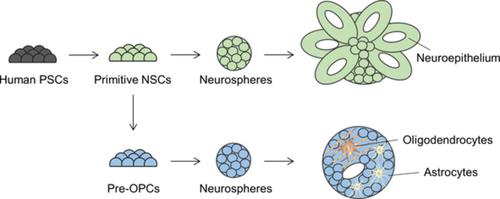当前位置:
X-MOL 学术
›
Stem Cells Transl. Med.
›
论文详情
Our official English website, www.x-mol.net, welcomes your feedback! (Note: you will need to create a separate account there.)
Rapid induction of gliogenesis in OLIG2 and NKX2.2-expressing progenitors-derived spheroids.
STEM CELLS Translational Medicine ( IF 6 ) Pub Date : 2020-07-27 , DOI: 10.1002/sctm.19-0455 Wonjin Yun 1, 2 , In Yong Kim 1, 2 , Gwonhwa Song 3 , Seungkwon You 1, 2
STEM CELLS Translational Medicine ( IF 6 ) Pub Date : 2020-07-27 , DOI: 10.1002/sctm.19-0455 Wonjin Yun 1, 2 , In Yong Kim 1, 2 , Gwonhwa Song 3 , Seungkwon You 1, 2
Affiliation

|
Glial cells are crucial for the development of the central nervous system and the maintenance of chemical homeostasis. The process of gliogenesis has been well studied in the rodent brain, but it remains less well studied in the human brain. In addition, rodent glial cells differ from human counterparts in terms of morphologies, functions, and anatomical locations. Cerebral organoids (also referred to as spheroids) derived from human pluripotent stem cells (hPSCs) have been developed and are suitable cell‐based models for researching developmental and neurodegenerative diseases. The in vitro generation of glia, including astrocytes and oligodendrocytes, from such organoids represents a promising tool to model neuronal diseases. Here, we showed that three‐dimensional (3D) culture of OLIG2‐ and NKX2.2‐expressing neurospheres produced efficiently mature astrocytes and oligodendrocytes in terms of morphologies and expression pattern recapitulating native 3D environment. Our findings provide important insights for developmental research of the human brain and glial specification that may facilitate patient‐specific disease modeling.
中文翻译:

在 OLIG2 和 NKX2.2 表达祖细胞衍生的球体中快速诱导胶质生成。
神经胶质细胞对于中枢神经系统的发育和化学稳态的维持至关重要。在啮齿动物的大脑中,胶质生成的过程已经得到了很好的研究,但在人脑中的研究仍然较少。此外,啮齿动物神经胶质细胞在形态、功能和解剖位置方面与人类对应物不同。已经开发出源自人类多能干细胞 (hPSC) 的脑类器官(也称为球体),是用于研究发育和神经退行性疾病的合适的基于细胞的模型。从这些类器官体外生成神经胶质细胞,包括星形胶质细胞和少突胶质细胞,是一种很有前景的神经元疾病模型工具。在这里,我们展示了 OLIG2- 和 NKX2 的三维(3D)培养。表达 2 的神经球在形态和表达模式方面有效地产生了成熟的星形胶质细胞和少突胶质细胞,重现了原生 3D 环境。我们的发现为人类大脑和神经胶质特征的发展研究提供了重要的见解,这可能有助于患者特定的疾病建模。
更新日期:2020-07-27
中文翻译:

在 OLIG2 和 NKX2.2 表达祖细胞衍生的球体中快速诱导胶质生成。
神经胶质细胞对于中枢神经系统的发育和化学稳态的维持至关重要。在啮齿动物的大脑中,胶质生成的过程已经得到了很好的研究,但在人脑中的研究仍然较少。此外,啮齿动物神经胶质细胞在形态、功能和解剖位置方面与人类对应物不同。已经开发出源自人类多能干细胞 (hPSC) 的脑类器官(也称为球体),是用于研究发育和神经退行性疾病的合适的基于细胞的模型。从这些类器官体外生成神经胶质细胞,包括星形胶质细胞和少突胶质细胞,是一种很有前景的神经元疾病模型工具。在这里,我们展示了 OLIG2- 和 NKX2 的三维(3D)培养。表达 2 的神经球在形态和表达模式方面有效地产生了成熟的星形胶质细胞和少突胶质细胞,重现了原生 3D 环境。我们的发现为人类大脑和神经胶质特征的发展研究提供了重要的见解,这可能有助于患者特定的疾病建模。



























 京公网安备 11010802027423号
京公网安备 11010802027423号